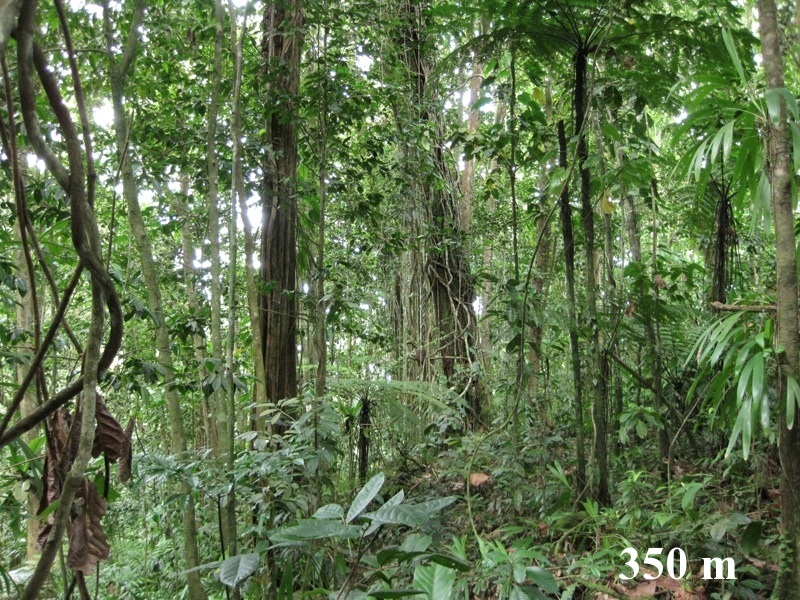A total of 649
samples of 50 cm2 of bryophytes were collected along La Soufrière transect and my task was to
determine the collections for these two lowland elevations: 350 m (107 samples) and 450 m (107 samples).
From August 2012 to May 2013, I stored the samples in paper envelopes as described in Bryolat/Moveclim Methodology
(Com. Pers. Claudine Ah-Peng) and I could sort out one quarter of the samples
collected at each level with the identification of species. Also I was taking
photos of almost every species.
I visited two national herbaria, to access reference
collections:
- The National Muséum of Natural History (PC) in Paris in
December 2012, where I could check especially Plagiochila specimens
- The New York Botanical Garden (NY) in March 2013, hosted
by B. Buck where my research focused on the Lejeuneaceae especially some
species also collected by Duss in the beginning of the 20th century
in Guadeloupe.
New York Botanical Garden, March 2013
I chose to process the samples so that we can have already some indications about the bryodiversity in
these areas. So to start, I studied approximately the same number of samples
collected at each altitude and in all types of supports.
Brief
description of the study sites:
The plots 350 m are in a rainforest partially modified
by human activities. Large boulders occur there. This forest is out of the
National Park, near flower plantations or other open areas.
Information on the bryophyte samples
from La Soufrière Transect (June 2012)
A total of 41 liverworts (21 genera, 6 families) and
24 mosses (16 genera, 10 families) are so far identified. Twenty-one other
species were identified at a genus level.
There was no terricolous species at both levels, neither
humicolous species at 350 m, nor rupicolous species at 450 m. At the elevation of
350 m, 26 species (13 liverworts and 13 mosses) were identified and 11
liverworts are identified at the genus level. At the elevation of 450 m, 46
species (33 liverworts and 13 mosses) were identified and 7 liverworts and 3
mosses are determined at the genus level.
7 species are common for these two lower elevations (350
and 450 m): Ceratolejeunea
laetefusca, Lejeunea asperrima, Lejeunea controversa, Telaranea nematodes,
Radula kegelii, Vesicularia vesicularis var rutilans and Lepidopilum scabrisetum
Among the liverworts, the Lejeuneaceae is the most speciose
family in the recorded samples.
Four of the six Cyclolejeunea
cited to Guadeloupe archipelago (Lavocat Bernard & Schäfer-Verwimp 2011)
were found at 450 m particularly on leaves. Cyclolejeunea
convexistipa seems to be a predominant species that is forming large
patches as epiphyllous (on living leaves).
Seven species (5 genera) of Lepidoziaceae and 2 Cephaloziaceae (Cephalozia
crassifolia, Odontoschisma longiflorum) were found at 450 m in corticoulous
and humicolous samples.
Some other liverworts of the genus Plagiochila,
Radula, Riccardia and Metzgeria
The moss family Pilotrichaceae
is well represented in plots 350 m with 3 species of Callicostella (C.
belangeriana, C. depressa, C. pallida), Hypnella
pallescens, Pilotrichum evanescens and 2 species of Lepidopilum (L. scabrisetum and L. polytrichoides).
Lepidopilum scabrisetum is the most frequent species in corticolous and rupicolous
samples and was found at both levels, but much more abundant in plots 350 m
with often a large bryophyte cover in dense populations.
Hypnella
pallescens, Callicostella belangeriana and Callicostella
depressa were not recently observed in Guadeloupe.
The
Neckeraceae is represented in plots 350 m by Neckeropsis undulata in discrete patches on corticolous samples and
by Neckeropsis disticha , a rather
mesophylic species common in lowland forests, very abundant especially on lianas.
In plots 450 m the species Homaliodendron piniforme is very
abundant on corticolous samples with dense and compact populations.
Among the Calymperaceae one
species was identified in plots 350 m: Calymperes afzelii and 4 species at 450 m: Calymperes lonchophyllum, Syrrhopodon ligulatus, S. lycopodioides and S. prolifer var scaber
One species of Thuidiaceae, Thuidium tomentosum is forming dense mats in rupiculous samples at
350 m.
These so far collected data could already give an idea
about the composition of the bryoflora and the bryodiversity. Thought I only
treated a quarter of the samples, I had a brief look on almost all other
samples, and the taxonomic and ecological trend will be
confirmed in the final results.
A New record to
Guadeloupe
During this field trip, we also collected with
National Park collecting permit some bryophytes in areas closed to the plots.
Among the specimens I collected at elevation 1250 m in highland low shrubs (Col de l’Échelle), I discovered a new record for Guadeloupe: Mytilopsis albifrons Spruce, a very small and delicate
species (confirmed Det by S.R.
Gradstein with photos). This species was reported to Jamaica, Guyana Highland,
northern Andes (Venezuela to Peru), Brazil (Gradstein et Costa 2003) and more
recently to Costa Rica (Dauphin 2005).
The identifications of the
remaining samples of La Soufrière Transect will probably result in more new
records for Guadeloupe, and increase the knowledge of the ecology of bryophytes.
Elisabeth Lavocat Bernard
National Botanical Conservatory of Guadeloupe
All Rights on the Photographs : Elisabeth Lavocat Bernard
References
Lavocat
Bernard E., Schäfer-Verwimp A. 2011. Checklist of the bryophytes of the Guadeloupe
archipelago and Martinique (French West Indies)


















No comments:
Post a Comment